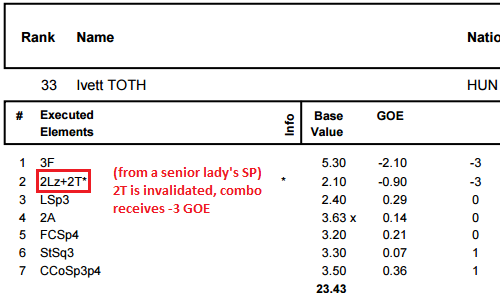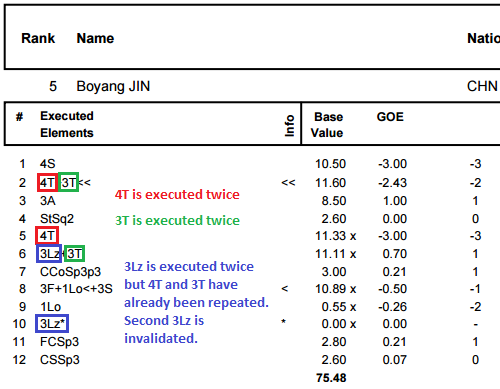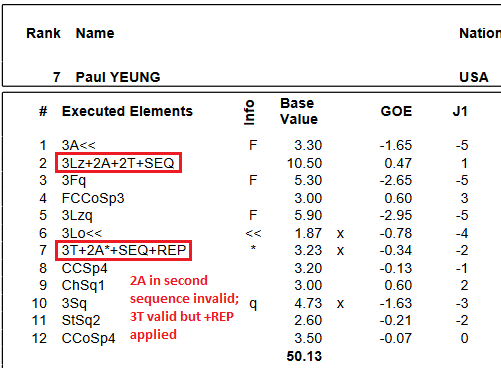
Jump Layouts and Invalid Jumps
Jump Layouts and Invalid Jumps in Singles Skating
Wondering why a skater's score was so low even though they seemed to land all of their jumps? Invalid elements might be one of the culprits. This guide will provide examples of invalid jumps and explanations for why they were invalid. All example protocols shown here are still relevant to the latest ISU rules, although some protocols may be several seasons old.
Please do not reproduce any part of this post without permission.
Reference: 2024-25 ISU Technical Panel Handbook for Singles Skating
LAST UPDATED: Aug. 20, 2024
Table of Contents:
SHORT PROGRAM RULES
IN GENERAL:
A short program should have 3 jumping passes in total for both women and men, one of which must be an axel, one solo jump which is not an axel, and one combination.
EXAMPLE 1: DOUBLED OR SINGLED SOLO JUMP
Short Program...must include:
Senior Men - any triple or a quadruple jump;
Senior Women - any triple jump
The senior short program must include a non-axel solo jump with either 3 or 4 rotations. Any double or single solo jumps are invalid and receive 0 points. Here is an example of a doubled lutz, which did not receive any value:
Additionally, junior skaters must perform a specific type of double or triple solo jump in the short program, depending on the season. If they do the wrong type of jump, it will be invalid.
EXAMPLE 2: SINGLED AXEL
Short Program...must include: double or triple Axel for Senior & Junior Men and for Senior Women, double Axel for Junior Women
The short program must include at least a double axel; single axels receive 0 points. An example of a single axel:
EXAMPLE 3: POPPING JUMPS IN A COMBINATION
Short Program must include a Jump Combination consisting of two jumps:
Senior Men: double and triple or two triples or quadruple and a double or triple;
Senior Women and Junior Men: double and triple or two triples;
Junior Women: combination of two double jumps is also permitted.
Jumps which do not satisfy the requirements (including wrong number of revolutions) will have no value, but will block a jumping box, if one is empty; if a combination of two double jumps is not allowed (Sr. Men & Women, Jr. Men), the jump with the lesser value (after the consideration of signs <, <<, e) will not count.
Popping one jump in a combination usually does not invalidate the entire combination, but if one jump in a combo is invalidated, the entire combo will receive the lowest possible GOE (-3 before the 2018-19 season, -5 from 2018-19 onwards). In an illegal double-double combo, only the jump with the lesser base value (after applying underrotations or edge calls) in the combo is invalidated. In a double-single or triple-single combo, the single jump is invalidated. If both jumps in the combo are singled, the entire combo is invalidated. Here are a few examples:
Additional note: We don’t have an example of it happening, but if a skater performs 3 jumps in a short program combination, the third jump in that combination will be invalid. There can be only one combination in the short program and it can contain only two jumps.
EXAMPLE 4: SAME JUMP PERFORMED AS SOLO JUMP AND AS PART OF COMBINATION
If the same jump is executed twice as a solo jump and as a part of the jump combination, the second execution will not be counted (if this repetition is in a jump combination, only the individual jump which is not according to the above requirements will not be counted). Only the jump combination can contain two same jumps.
The same jump cannot appear as both the solo jump and in the combination of a short program. In the following example, Grant popped his planned 4T into a 2T, then popped the planned 3T in the combination into a 2T. Since there was a 2T in both the combination and as the solo jump, the 2T in the combination was invalidated, while the 3Lz in the combination was still valid. (This same kind of problem can happen when skaters triple their planned 4Ts and forget that they can't do another 3T in the combination afterwards.) Grant's solo 2T was also invalidated because solo doubles are not allowed in senior short programs, as seen in Example 1 above.
Before the 2016-17 season, if a skater performed the same jump in the combination and as the solo jump, the entire combination would be invalidated.
EXAMPLE 5: WEIGHT TRANSFER OFF LANDING FOOT IN A JUMP COMBINATION
Fall/step out or touch down with free foot with weight transfer after a jump plus another jump: If a skater falls or steps out on a jump and immediately after that executes another jump, the element will be called as follows: “First Jump + Combo + Second Jump*”
In the following example, Yuzuru lost balance on the landing of his 4S and transferred his weight onto his free foot; the 2T that he added onto the 4S was therefore invalid. The base value of the valid jump is not affected. This rule applies to combinations in the free skate as well.
FREE SKATE RULES
IN GENERAL:
A free program should have 7 jumping passes in total for both women and men, at least one of which must be an axel.
If any jump/s in a combination/sequence is not according to the requirements, only the jump/s not according to requirements will be deleted.
Starting from the 2016-17 season, invalid jumps in a combination do not invalidate the entire combination.
EXAMPLE 1: TOO MANY OF ONE KIND OF DOUBLE
Any double jump (including double Axel) cannot be included more than twice in total in a Single’s Free Program (as a Solo Jump or a part of Combination / Sequence).
In the following example, Wakaba performed three 2Ts. The third 2T, which occurred in a 2A2T combination, was invalidated, but the 2A in the combination was still valid.
The restriction on all types of double jumps first came into effect in the 2014-15 season. (Double axels had already been limited to 2 per free skate since the 2010-11 season.)
EXAMPLE 2: TOO MANY OF ONE KIND OF TRIPLE, QUAD, OR QUINT
No triple or quadruple or quint jump can be attempted more than twice.
In the following example, Sergei performed three triple toeloops. The third 3T was invalidated, but the first 3T in the 3T3T combination was still valid.
The “too-many-of-the-same-jump” rule is colloquially referred to as the "Zayak rule" after skater Elaine Zayak. Many fans also use "zayaking" to refer to breaking any kind of jump layout rule.
EXAMPLE 3: TOO MANY COMBINATIONS
There may be up to three jump combinations or two jump combinations and one jump sequence in the Free Program. […] If the total number of jump combinations or sequences is more than three, only the first jump of the extra jump combinations/sequences is counted. This jump will be marked with the sign "+REP" and receive 70% of the base value (as a repetition of a jump combination/sequence), eg. 3Lo+3T*+REP, 3Lo+3T*+2A*+SEQ+REP, etc.)
In the following example, Evgenia did four combinations. Only the 2A in the fourth combo was valid, while the second jump was invalidated. The 2A also received +REP and a base value reduction. (The 3T in her 2A3T combination also violates the rule in Example 2 above, since it is the third 3T performed in the program.)
EXAMPLE 4: TOO MANY TYPES OF TRIPLES/QUADS/QUINTS REPEATED
Of all triple and quadruple and quint jumps only two (2) can be executed twice. Of the two repetitions only one (1) can be a quadruple jump or a quint jump.
In the following example, Boyang repeated (in order) two 4Ts and two 3Ts. He now cannot do any other type of triple or quad more than once. However, he then included two 3Lzs, resulting in the invalidation of his second 3Lz.
Here is another example:
EXAMPLE 5: TOO MANY JUMPING PASSES
A well balanced Free Skating program must contain: 7 jumping elements for Senior & Junior, Men & Women one of which must be (or must include) an Axel type jump.
In the following example, Riona attempted 8 jumping passes in her free skate. The "Lz" did not receive any value as she did not manage to complete any rotations of the jump, but it was still counted as a jump attempt. When she attempted a loop at the end of the program, it was counted as her 8th jumping pass and invalidated.
EXAMPLE 6: TOO MANY 3-JUMP COMBINATIONS
Second jump combo or sequence with 3 jumps: One jump combination or one jump sequence may consist of up to three jumps. Only the jumps not according to requirements will receive no value.
Only one 3-jump combination or sequence is allowed in the free skate. In the following example, Misha did two 3-jump combos, and the third jump in his second 3-jump combo was invalidated. The first two jumps in the combo were still valid.
EXAMPLE 7: WEIGHT TRANSFER OFF LANDING FOOT IN A JUMP COMBINATION
If in a jump combination or sequence a skater falls or steps out of a jump and immediately executes another jump(s), the jump(s) after the mistake are not counted, and the call will be the executed jump(s) before the mistake + combo/sequence + the executed jump(s). The jumps after the mistake are marked with an *.
In the following example, Jill transferred weight off of her landing foot on her 3F and 3Lz; the following jumps were invalidated. The base values of the valid jumps are not affected. This rule applies to combinations in the short program as well.
EXAMPLE 8: NO AXEL IN PROGRAM
A well balanced Free Skating program must contain: 7 jumping elements for Senior & Junior, Men & Women, one of which must be (or must include) an Axel type jump.
In the following example, Dmitri did not perform any axels in his free skate, so the last jumping pass he performed (3Lz2T) was invalidated.
EXAMPLE 9: TOO MANY JUMP SEQUENCES
There can only be one jump sequence in a Free program. If the skater executes two jump sequences in a program, only the first jump of the jump unit will count.
First jump sequence in the program: 3T + 2A + Seq
Second jump sequence in the program: 3S + 1A* + 2T* + REP
Second jump sequence in the program: 3S + 2T* + 1A* + REP
Only one jump sequence is allowed in the free program. In the following example, Paul performed two sequences, and the 2A in his second sequence was invalidated. The 3T in the second sequence also received +REP and a base value reduction.

















